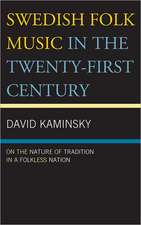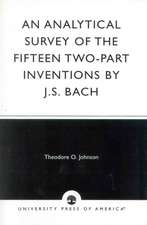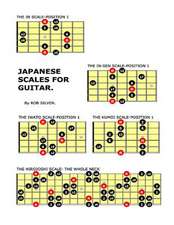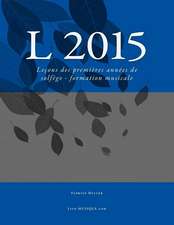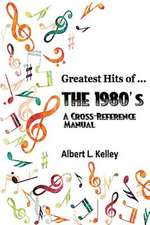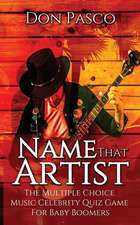Music Theory Secrets: Music Secrets for the Starting Musician
Autor Brent Coppenbargeren Limba Engleză Paperback – 20 aug 2014
Preț: 423.60 lei
Nou
Puncte Express: 635
Preț estimativ în valută:
81.05€ • 84.86$ • 67.07£
81.05€ • 84.86$ • 67.07£
Carte tipărită la comandă
Livrare economică 07-21 aprilie
Preluare comenzi: 021 569.72.76
Specificații
ISBN-13: 9781442233232
ISBN-10: 1442233230
Pagini: 156
Ilustrații: 109 black & white illustrations, 7 tables
Dimensiuni: 178 x 253 x 9 mm
Greutate: 0.3 kg
Ediția:New.
Editura: Rowman & Littlefield
Seria Music Secrets for the Starting Musician
ISBN-10: 1442233230
Pagini: 156
Ilustrații: 109 black & white illustrations, 7 tables
Dimensiuni: 178 x 253 x 9 mm
Greutate: 0.3 kg
Ediția:New.
Editura: Rowman & Littlefield
Seria Music Secrets for the Starting Musician
Notă biografică
Cuprins
Quick Reference Guide to Helpful Tables
Preface
Acknowledgments
Prelude
Chapter 1: Pitch and Rhythm Basics
Secret 1: Pitch Basics
Secret 2: The Treble Clef or G Clef
Secret 3: The Bass Clef or F Clef
Secret 4: The Alto Clef & The Tenor Clef
Secret 5: The Grand Staff
Secret 6: Rhythm
Secret 7: Time Signature
Secret 8: Meter
Secret 9: Simple Meter
Secret 10: Compound Meter
Secret 11: Asymmetrical Meter
Secret 12: Counting in Simple Meter
Secret 13: Counting in Compound Meter
Secret 14: Practice Makes Perfect
Chapter 2: Major Scales and Major Key Signatures
Secret 15: The Scale
Secret 16: The Major Scale
Secret 17: The Major Tetrachord
Secret 18: Key Signatures
Secret 19: The Order of Flats
Secret 20: The Order of Sharps
Secret 21: The Sharp Key Signatures in Major
Secret 22: The Flat Key Signatures in Major
Chapter 3: Minor Scales and Minor Key Signatures
Secret 23: Minor Scales
Secret 24: Parallel Minor
Secret 25: Relative Minor
Secret 26: Natural Minor Form
Secret 27: Harmonic Minor Form
Secret 28: Melodic Minor Form
Chapter 4: Other Scales
Secret 29: The Chromatic Scale
Secret 30: The Whole Tone Scale
Secret 31: The Pentatonic Scale
Secret 32: Dorian Mode
Secret 33: Phrygian Mode
Secret 34: Lydian Mode
Secret 35: Mixolydian Mode
Secret 36: The Seven Note Blues Scale
Secret 37: The Bebop Scale
Secret 38: Less Common Scales
Chapter 5: Scale Degree Names and Intervals
Secret 39: Scale Degree Names
Secret 40: The Interval
Secret 41: Major Intervals
Secret 42: Perfect Intervals
Secret 43: Minor Intervals
Secret 44: Augmented Intervals
Secret 45: Diminished Intervals
Secret 46: The Tritone
Chapter 6: Triads
Secret 47: Major Triads
Secret 48: Minor Triads
Secret 49: Augmented Triads
Secret 50: Diminished Triads
Chapter 7: Chords
Secret 51: The Major Seventh Chord
Secret 52: The Major-Minor Seventh Chord
Secret 53: The Minor Seventh Chord
Secret 54: The Diminished Seventh Chord
Secret 55: The Half-Diminished & Fully-Diminished Seventh Chord
Secret 56: Other Chords
Chapter 8: Roman Numeral Analysis
Secret 57: Roman Numeral Quality
Secret 58: Roman Numerals in Major Keys
Secret 59: Roman Numerals in Minor Keys
Secret 60: Four-Part Roman Numeral Analysis
Chapter 9: Inversions of the Chord and Figured Bass
Secret 61: The Root Position Triad
Secret 62: The First Inversion Triad
Secret 63: The Second Inversion Triad
Secret 64: Figured Bass
Secret 65: Root Position Figured Bass
Secret 66: First Inversion Figured Bass
Secret 67: Second Inversion Figured Bass
Secret 68: Seventh Chord Figured Bass
Secret 69: Lead Sheet Inversions
Chapter 10: Non-Chord Tones
Secret 70: Non-Chord Tones Defined
Secret 71: The Passing Tone
Secret 72: The Neighbor Tone
Secret 73: The Escape Tone
Secret 74: The Appoggiatura
Secret 75: The Anticipation
Secret 76: The Suspension
Secret 77: The Pedal Tone
Secret 78: Using Non-Chord Tones To Improvise
Chapter 11: Singing with Solfège Syllables
Secret 79: Sight Singing
Secret 80: Solfège Syllables in Major
Secret 81: Solfège Syllables in Natural Minor
Secret 82: Solfège Syllables in Harmonic Minor
Secret 83: Solfège Syllables in Melodic Minor
Secret 84: Other Methods of Sight Singing
Chapter 12: Transposition
Secret 85: Concert Pitch Instruments
Secret 86: Transposing Instruments
Secret 87: Transposing Parts
Secret 88: Transposing Using Solfege Syllables
Secret 89: Transposing Keys
Secret 90: The Transposition Table
Chapter 13: Advanced Concepts
Secret 91: Four Part Analysis
Secret 92: Part-writing Rules
Secret 93: The Sequence
Secret 94: Form
Appendix 1: Chorale Analysis
Appendix 2: Suggested Further Reading
About the Author
Index
Descriere
Rhythms, melodies, and harmonies are the building blocks of music. In Music Theory Secrets: 94 Strategies for the Starting Musician, Brent Coppenbarger offers a full range of methods to help musicians, not only grasp, but remember those key elements upon which the music they play is built: pitch, rhythm, scales, key signatures, and harmony.

